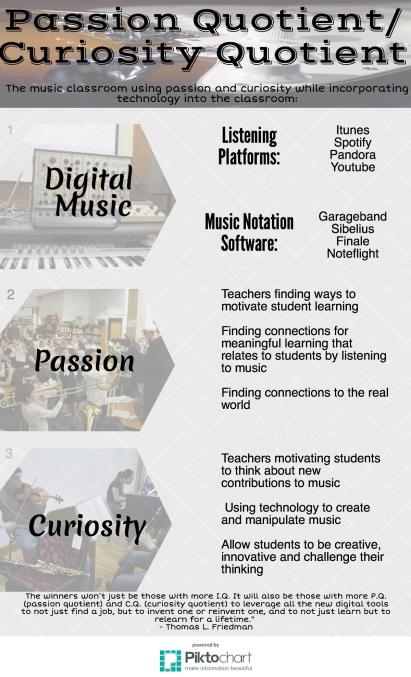During the last week of CEP812, we were asked to read the article It’s P.Q. and C.Q. as Much as I.Q. by Thomas L. Friedman. Throughout the article, Friedman discusses the need for people to continue utilizing technology to invent and/or reinvent future jobs while focusing on our individual passions and curiosities in order for survival. In education, we as teachers must utilize the technological tools available not to replace teaching but to continue educating with passion and curiosity in the 21st century classroom. It is up to each individual educator to keep up with their own teaching skills in order to keep up with an ever changing education system. When teachers are aware of their own passion and their own curiosity, they can then incorporate new ways to allow students to find theirs.
Below is an infographic created to:
- Represent how I bring Passion and Curiosity to my work as an educator
- Show how I use technologies to instill passion and curiosity in my students.
I have had the pleasure of taking CEP810, CEP811, and CEP812 to inspire my own curiosity of incorporating technology into my passion of teaching.
Photo References:
Emlavieriscull, E. Equipment for Electronic Music Class (2012). Retrieved August 19, 2015: https://commons.wikimedia.org/wiki/File:ElectroComp_EML-200,_etc,_Equipment_for_Electronic_Music_Class.jpg#/media/File:ElectroComp_EML-200,_etc,_Equipment_for_Electronic_Music_Class.jpg
Royan, J. Students Practicing (2007). Retrieved August 19, 2015 from: https://commons.wikimedia.org/wiki/File%3AMunich_-_Music_students_rehearsing_-_5713.jpg
Woodleywonderworks. Music Classroom (2013). Retrieved August 19, 2015 from: https://www.flickr.com/photos/wwworks/8509359758
Infographic Quote:
Friedman, T. (2013). It’s P.Q. and C.Q. as Much as I.Q. New York Times. Retrieved from: http://www.nytimes.com/2013/01/30/opinion/friedman-its-pq-and-cq-as-much-as-iq.html?_r=0





